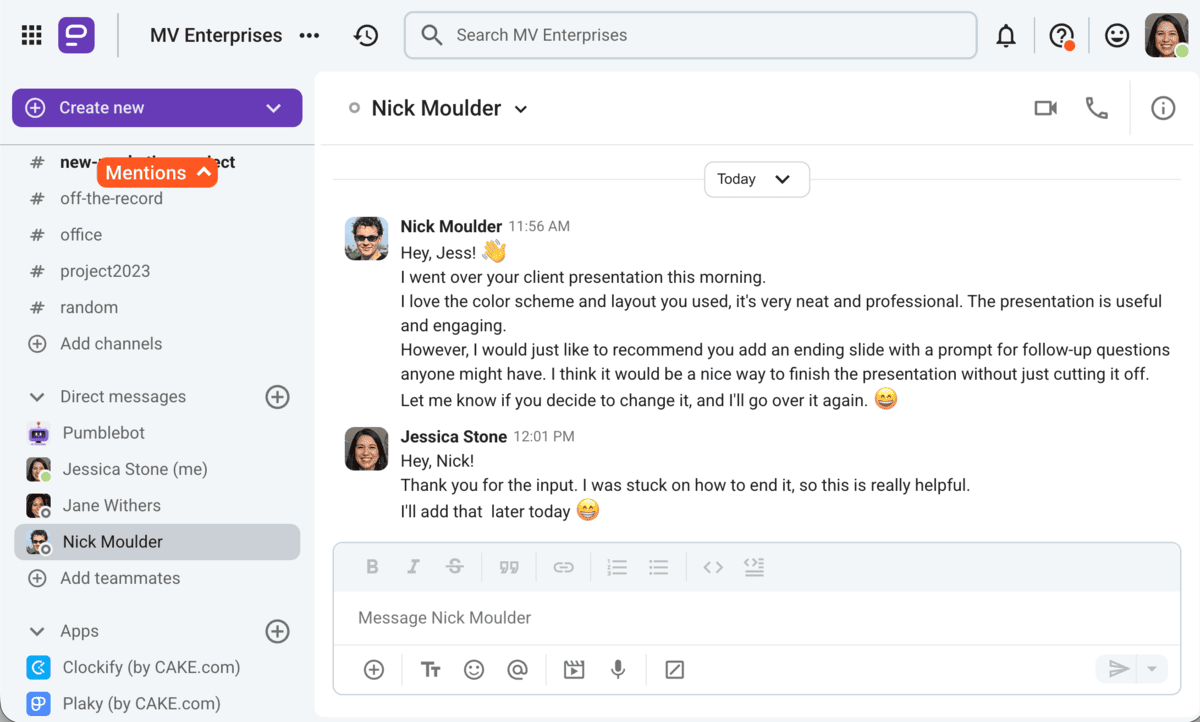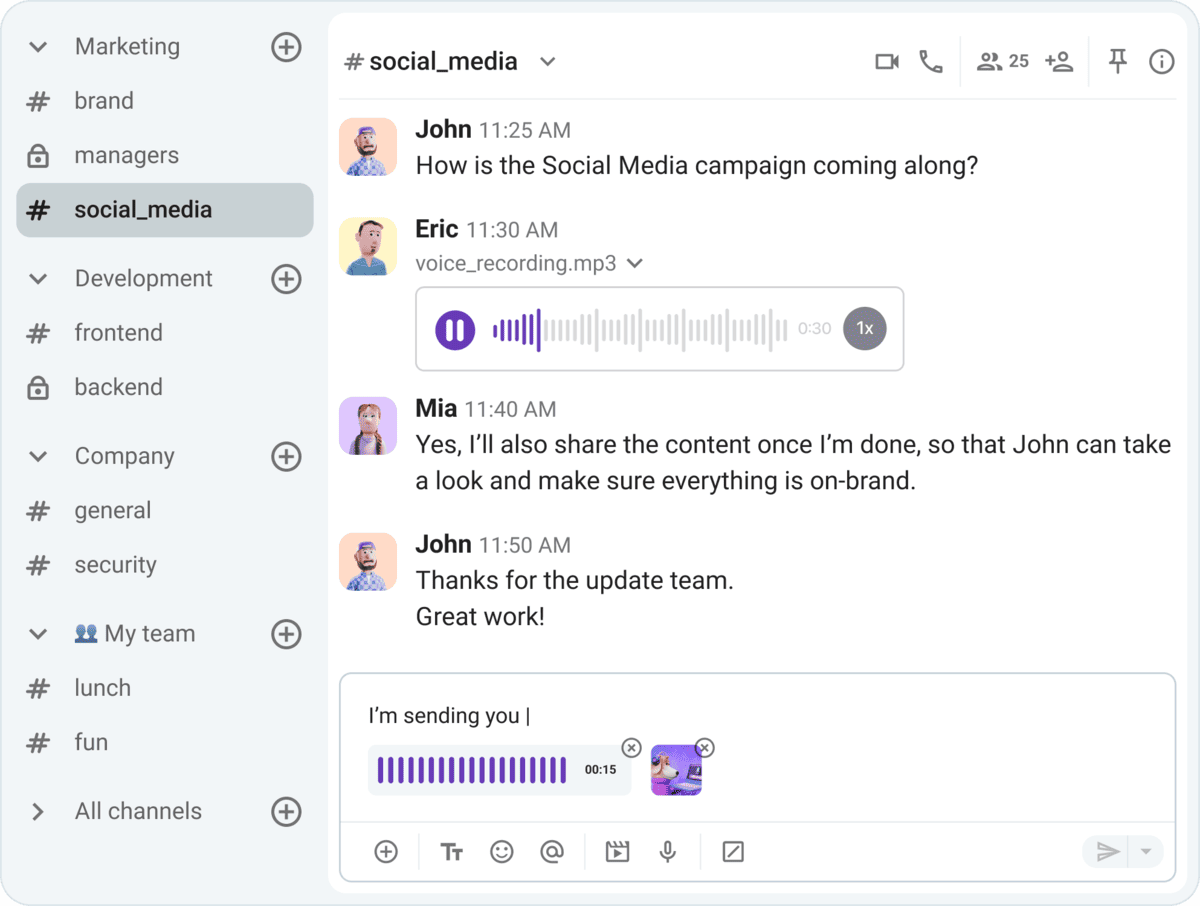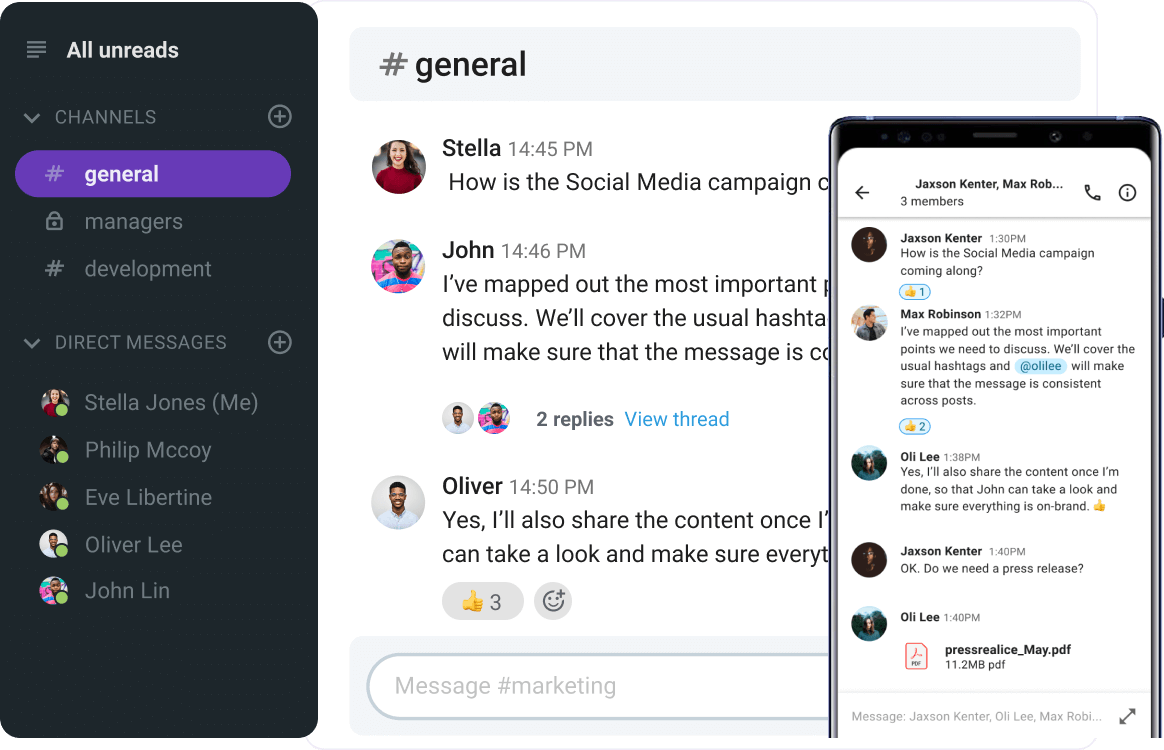In most work environments, communication determines everything — from how fast decisions are made to how teams collaborate and how much trust they feel.
But, it’s also where most things break down — a misunderstood email, a vague request, a meeting where everyone leaves thinking something different.
And when that happens, productivity tanks, trust erodes, and frustration quietly spreads.
The main cause of this is the lack of a skill that’s often misunderstood — direct communication. Too often, people equate being direct with being harsh or blunt. But real direct communication in the workplace isn’t about aggression, it’s about clarity, honesty, and respect.
Being direct is a learnable skill that creates faster, more effective, and more connected teams.
In this post, we’ll unpack what a direct communication style really is, why it’s so powerful, and how to practice direct communication in the workplace daily without creating conflict.
Let’s start.

- Direct communication is a style of communication that conveys information in a clear and straightforward manner.
- Indirect communication is a type of communication where you don’t directly convey information. Instead, you rely on ineffective methods of communication.
- Indirect communication in the workplace has detrimental effects on the productivity, effectiveness and overall health of your workplace.
- Direct communication is a skill that can be practiced and learned.
Table of Contents
What is direct communication?
Direct communication is a style of communication that conveys information in a clear and straightforward manner.
It means that you get to express your thoughts, needs, and feelings clearly and respectfully, without unnecessary filters or hidden meanings.
In short — a direct communication style ensures that what you say is what others hear. It’s an effective communication style that strikes a balance between:
- Honesty,
- Assertiveness, and
- Respect.
Unfortunately, direct communication is often misunderstood as being aggressive or blunt. However, true direct communication is:
- Assertive — not aggressive,
- Honest — not blunt, and
- Clear — not condescending or confrontational.
It’s not about being louder, tougher or more dominant, and the goal isn’t to “win” a conversation — it’s to make sure everyone is on the same page.
To better understand direct communication in the workplace, we can contrast it to less effective communication styles — passive, aggressive, and passive-aggressive.
Here’s how direct vs indirect communication styles compare in the same situation — when a team member misses a project deadline:
| Communication style | Example | Description | Result |
|---|---|---|---|
| Passive communication | “It’s okay, maybe next time you’ll plan better.” | Avoids confrontation; withholds true thoughts or feelings to “keep the peace”. | Confusion, repeated mistakes, and unspoken frustration that builds up. |
| Aggressive communication | “You completely dropped the ball. I can’t believe you missed the deadline again!” | Expresses frustration harshly; prioritizes one’s own needs and emotions. | Creates fear and resentment; shuts down collaboration. |
| Passive-aggressive communication | “Well, I guess we’ll all have to work late now to make up for this.” | Masks frustration behind sarcasm, guilt, or avoidance. | Creates mistrust and tension; problems remain unsolved. |
| Direct communication | “The deadline was missed, which puts the team behind. We will work together to correct it and review what happened to plan how to stay on track next time” | Communicates openly and respectfully; focuses on facts, impact, and solutions. | Creates clarity and strengthens trust; focuses on solving the problem. |
Put direct communication to use with Pumble
When you speak directly, you don’t sugarcoat, but you also don’t steamroll.
You lay down the facts, express your needs, and invite collaborative communication.
Over time, this approach builds trust and psychological safety — people know that your feedback and concerns come from a positive place, and are not intended to cause conflict.
💡 Pumble Pro Tip
Direct communication is a type of positive workplace communication. To learn more about positive and negative communication in the workplace, check out our blog:
What is indirect communication and why it fails
On the opposite side of the communication style spectrum lies indirect communication.
Indirect communication is a manner of communication where the speaker doesn’t directly state their thoughts, opinions, and feelings — meaning is implied rather than stated. Indirect communicators rely on tone, hints, or perceived shared assumptions instead of clear verbal communication.
For example, instead of saying “I need this report by Friday.”, they will say “It would be great if someone could do this soon.”.
Or, instead of saying “I disagree with that approach, let’s discuss another one.”, they might say “That’s an interesting idea.”, hoping the hesitation in their tone of voice will be perceived and understood.
This indirect style of communication has tangible effects on your organization.
Effective communication is easy with Pumble
The effects of indirect communication
Indirect communication may sometimes feel like the polite way to approach problems, but over the long term, it creates:
- Confusion,
- Misunderstandings,
- Inefficiency, and
- Communication breakdown.
Every vague comment, unclear request, or unspoken expectation adds friction:
- Teams waste hours clarifying what could have been clearly communicated from the beginning.
- Meetings run long because people dance around the real issue.
- Projects stall because teams are working in silos, no one knows who’s responsible, and what the next steps are supposed to be.
Indirect communication in the workplace tanks productivity, increases stress, and is also costly.
This is supported by various workplace communication statistics:
- 86% of workers believe ineffective communication is the underlying reason for workplace failures.
- 64% of business leaders believe that effective communication has increased their team’s productivity, and 55% of employees agree.
- 51% of employees feel that poor communication has increased their overall stress levels, and 41% note a decrease in productivity due to poor communication.
- Only 46% of employees clearly know what’s expected of them at work.
- 40% of leaders believe that poor communication decreases productivity.
Additionally, ineffective communication costs businesses between $10,000 and $55,000 per employee per year.
Indirect communication leaves space for misinterpretation, forces employees to guess intentions, and breeds mistrust — because what’s left unsaid can sometimes feel more personal than what’s said plainly.
In short, indirect communication is expensive — not only in money and time, but also in energy, morale and trust.
5 Actionable tips on how to be more direct in your communication
Contrary to popular communication myths, direct communication isn’t innate — it’s a skill that can be learned, practiced and mastered.
Here are 5 actionable and practical strategies for becoming clearer and more direct in your interpersonal communication — without crossing the line into rudeness.
#1 Use “I” statements to bring focus to what you feel
Using “I” statements deescalates conflicts by focusing on what you feel and want to share, rather than on what the other person did wrong.
This way, you can turn potentially confrontational situations into collaborative exchanges.
For example:
- Accusatory and ineffective — “You never meet deadlines.”
- Direct and effective — “I get stressed when deadlines slip because it affects my schedule too.”
This assertive approach lets you express your experience without criticizing, blaming, or attacking others.
It’s also less likely to cause defensiveness or have the other person shut down, because you’re focused on the problem rather than attacking the person.
Additionally, “I” statements are supposed to be a conversation-starter about the problem you’re experiencing — so, don’t expect a single message to be sufficient in getting your point across.
Treat it as an opportunity to open up a healthy two-way conversation.
Start one-on-one conversations in Pumble
#2 Be specific to ensure clarity
Clarity needs details.
General feedback leaves people confused and demotivated, while specific feedback gives them direction.
For example, an imprecise comment such as “This report needs more work.” will leave team members guessing what to fix, while specific feedback like “The conclusion should include a summary of the strong evidence we have to support our main argument.” gives clear direction and purpose.

Being specific and transparent in your communication turns criticism into actionable guidance. It also shows respect — you’ve paid attention and invested effort to identify what can be improved.
The clearer and more specific you are, even if you feel like you’re at the risk of overcommunicating, the faster and better your team can act, and the less room there is for misunderstanding or wasted effort.
Give constructive feedback with Pumble
💡 Pumble Pro Tip
Clarity is one of the essential principles of good communication. To learn about the other 9, check out out blog post:
#3 Separate the person from the problem to avoid getting personal
The direct communication style demands you to be straightforward and assertive.
However, you should never cross the line into personal attacks or belittling and name-calling others.
This is especially important when you’re giving feedback — you should be focused on behaviors and outcomes, not personal traits or faults.
For example:
- Attacks the person — “You’re careless.”
- Focuses on the problem — “I noticed several mistakes in the report. Can we add a review step before finalizing next time?”
This distinction keeps the discussion professional, not personal and signals that your intention is improvement, not criticism.
💡 Pumble Pro Tip
Conflicts are unavoidable in the workplace, but how you handle them is most important. Here are 15 conflict resolution phrases to use to deescalate conflicts and turn them into collaborative exchanges:
#4 Practice active listening to be able to respond directly
Direct communication isn’t just about what you say — it’s also about how well you listen.
Practicing active listening means giving your full attention, reflecting back what you’ve heard, and asking clarifying questions.
For example, “Just to make sure I got this — you’re saying the issue is more about timing than scope, right?”
This seemingly small habit prevents assumptions and misunderstandings. It also shows respect for the speaker.
Active listening is one of the most overlooked parts of healthy communication, yet it’s the one that builds the most trust — when people feel heard, they’re more open to hearing you in return.
💡 Pumble Pro Tip
To learn more about active communication, and why it’s so important in workplace communication, check out our guide:
#5 State your intentions first to avoid misinterpretation
The way you start your conversation shapes how it will progress.
Leading with your intentions sets a constructive tone and prevents your message from being misinterpreted.
For example, saying “I’d like to share some feedback that could make the report even better.”, instantly signals that your goal is collaboration, not criticism.
It helps the listener relax and engage instead of bracing for impact. When people understand why you’re bringing something up, they can focus on the content instead of worrying about your motive.
Setting clear intentions from the start keeps discussions on track and helps everyone feel more comfortable, even in difficult conversations.
The right environment for direct communication: How your tools can help
Even the best communicators struggle in systems that encourage vagueness.
Traditional tools like email often enable ambiguity. Endless CCs, buried email threads, and mixed contexts make it hard to stay clear and direct.
To build a culture of direct communication, you need tools designed to support it.
That’s where Pumble by CAKE.com comes in. Pumble is a team communication and collaboration tool built for clear and organized communication.
Pumble provides the right infrastructure for clarity, accountability, and direct communication.
Let’s see exactly how Pumble can help you streamline your workplace communication.
Threads for focused conversations and relevant feedback
Pumble’s threaded conversations keep discussions organized and on-topic.
Instead of cluttering the main conversation or putting someone on the spot publicly, threads allow for focused and respectful feedback within the right context.
For example, if a team member sends a project update, feedback can happen directly in that thread.

Pumble’s threads allow for an organized and direct approach to communication, without unnecessary clutter.
Eliminate clutter and stay on track with Pumble
Channels for clarity with instant context
Pumble’s dedicated channels give every message clear and instant context.
For example, when you share updates in #project-december or some feedback in #marketing-reports, team members immediately know what the message is about and what team it’s meant for.

You don’t need to give a detailed description of the project or reference earlier emails that contain what you want to comment on.
That clarity prevents misunderstandings — team members instantly know why the message matters and who it’s for.
With this directly incorporated context, messages are never random or out of place.
Experience organized communication with Pumble
Unlimited message history for a record of clarity
When teams use multiple communication tools, older messages disappear, or get hidden behind paywalls — and with them go context and clarity.
That’s how confusion happens, and you get questions such as “Didn’t we agree on that already?” or “When did you send that?”.
With Pumble’s free unlimited messaging history, you have access to all your messages, forever.
Every decision, agreement, along with shared documents and files, remains accessible and searchable.
It also prevents ambiguity and the “he said, she said” problem.
With Pumble, teams don’t waste time revisiting settled questions or resending lost files — they always have a clear shared history to look back on.
Stop wasting time — try Pumble
Direct communication is easier with Pumble
Direct communication isn’t a personality trait or a natural gift — it’s a discipline that anyone can practice and master.
In essence, it’s about saying what you mean in a way that others can understand, trust, and act on.
With tools like Pumble, it’s easy to make direct communication part of everyday work culture.
Ready to start experiencing the benefits of direct communication?
